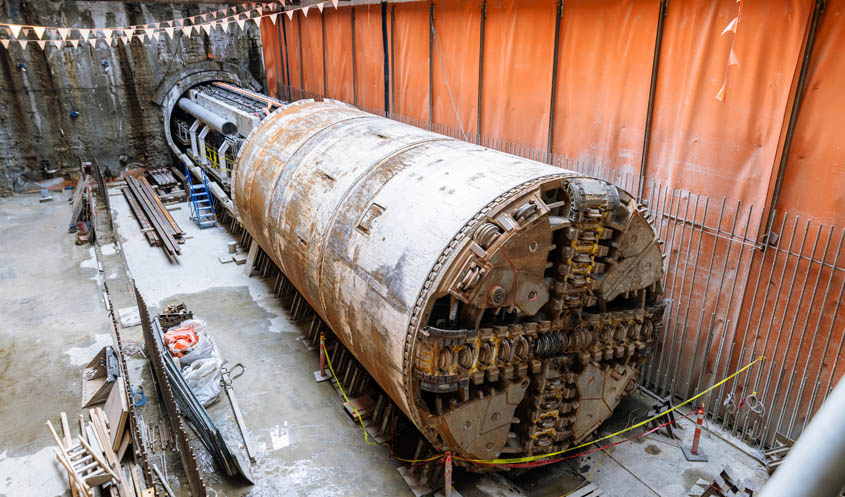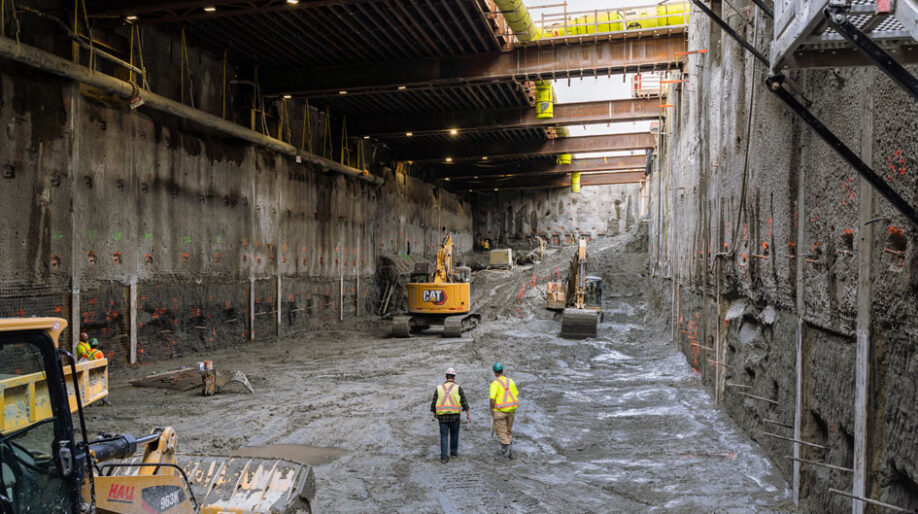The new $2.83 billion Broadway Subway project is a massive undertaking that will transform one of the most congested and critical transportation corridors in Metro Vancouver.
Construction of the 5.7 km extension of the Millennium Line, from VCC-Clark Station to the Broadway and Arbutus intersection began in 2020. The project scope features a 700-metre elevated guideway section, five kilometres of tunnel and six new stations including an underground direct connection to the existing Canada Line.
The Broadway Subway Project Corporation, a joint venture of Acciona Infrastructure Canada Inc. and Ghella Canada Ltd., is delivering the project under a design-build-finance contract. The subway is anticipated for completion in 2026.
“When completed the Broadway Subway Project will slash pollution and commuter times, bringing safe, comfortable modern transit to one of the busiest transit corridors in Metro Vancouver,” says Carlos Planelles, managing director of Acciona North America.
Crews have been making steady progress on the project with active construction ongoing at the six station sites and the elevated guideway. The focus this year is to continue building the stations, completing the tunnel boring operations and beginning the SkyTrain track installation.
Concrete walls, pillars and floors at the new stations are being carried out in phases. An estimated total of 210,000 cubic metres of concrete will be used for this project.
“Crews at the elevated guideway are currently constructing the parapets on top of the concrete deck, which will run alongside the SkyTrain tracks. Installation of the SkyTrain tracks will begin at the elevated guideway this year,” says Dave Crebo, communications director, the Ministry of Transportation and Infrastructure. “The project’s two TBMs, Elsie and Phyllis, will arrive at Cypress Street this spring.”
TBMS & TUNNELING

The two cylindrical tunnel-boring machines (TBMs), Elsie and Phyllis, are central to the project’s success. Named after two influential women from B.C. history, each TBM is six metres wide and weighs one million kilograms. They were custom designed for the unique geological conditions along the Broadway corridor.
Built in Germany, they were shipped to Vancouver in 2022 (using 40 containers plus 12 oversized pieces) and then assembled on site at the future Great Northern Way-Emily Carr Station. The TBMs were launched separately in October and November 2022. Each TBM is expected to take about a year to carve out the subway’s inbound and outbound tunnels, advancing approximately 18 metres per day. Tunnels are approximately 15 metres below grade to a maximum of 20 metres at Broadway-City Hall.
Both TBMS broke through the Oak-VGH Station late last year, representing the halfway mark. TBM Phyllis began boring towards Arbutus Station (last of the stations) on February 2 while TBM Elsie arrived at South Granville Station on February 8. In total, the two TBMs will install approximately 4,500 tunnel liner rings and excavate almost 760,000 cubic metres of soil.
“There are eight to 12 crew underground in the TBM working 10-hour shifts,” notes Crebo.
STATIONS
From west to east, the five new stations will be Arbutus, South Granville, Oak-VGH, Mount Pleasant and Great Northern Way-Emily Carr.
Broadway-City Hall will be the line’s deepest station at more than 20m underground, allowing the new twin tunnels to be built below the existing Canada Line. Broadway-City Hall will share a name and entrance with the existing Canada Line station.
Designed with “Crime Prevention Through Environmental Design” principles, the stations will include open and transparent layout, good lighting, and state-of-the-art security systems to maximize visibility and safety.
Dialog Design is providing architectural, structural, mechanical, electrical, and planning and landscape services for underground stations and at-grade exits / street interfaces. The firm is responsible for the two stations at the ends of the line: Arbutus and Great Northern Way – Emily Carr.
“The new Broadway Subway Project is a city-building project. When you look at the positive impact of the Canada Line rapid transit line to YVR Airport, it’s easy to see how the new subway will have the same positive effect on the Broadway Corridor and areas as far west as the UBC campus,” says Martin Nielsen, Dialog principal-in-charge.
IBI Group is serving as architect and engineer of record for four of the stations, including the complex Broadway-City Hall Interchange Station. IBI Group will also be providing design services on road alignments, traffic diversions, and road furniture modifications required to support the new subway stations and alignment.
“Our vision for the station design centres on our passenger-first philosophy; to make it easier for Vancouverites to live, work, travel and shop, and to support the continued growth of the Broadway Corridor,” says Charlie Hoang, IBI Group global lead, transit architecture.
Each station will feature unique designs and varying levels of integration with future development, which will help support new transit-oriented communities.
For example, the South Granville Station will be integrated into a new 39-storey mixed-use private development, currently under construction.
“This is the first time that a new SkyTrain station has been integrated into a newly built development constructed at the same time. This is consistent with how rapid transit projects are planned in other major centres,” says Crebo, adding the future Great Northern Way-Emily Carr Station is also expected to be incorporated into a new development.
CHALLENGES
Building a project of this scale and size is already daunting. Then add on top of that a dense urban environment and the technical challenges increase dramatically. Keeping traffic moving on the corridor is a major priority and the biggest challenge.
“We have a commitment to ensure that traffic keeps moving on Broadway, access is maintained to businesses, medical facilities and residences, buses are prioritized and noise and vibration impacts are mitigated as much as possible,” says Crebo.
Minimizing traffic disruption along Broadway required an innovative engineering solution by structural engineers Allnorth Consultants. Five temporary traffic decks were installed at station sites – each four lanes wide, and one to two blocks long – acting as bridges for traffic to pass over worksites. The traffic decks allow four lanes of traffic throughout construction, two in each direction, with priority for buses and emergency vehicles.
Allnorth developed a novel design which allowed for deck installation without halting traffic, while supporting both vertical traffic loads and horizontal soil pressures on station excavation.
Each girder supporting the traffic deck is approx. 20 m long, 1.1 m wide and weighs 20 tons. The largest of the five traffic decks is at the future Arbutus Station and has 58 columns and 29 girders supporting 148 road panels. This is the first time these traffic decks have been used on a large-scale in Vancouver. The decks were also designed to be modular to follow the phased construction sequence.
According to Allnorth, there were continuous challenges due to the extremely busy area that required problem solving and the application of out of the box solutions.
“Installation was a major undertaking,” notes Crebo. “This engineering solution means traffic can flow above completely separated from the construction of the station underneath.”
In addition, working near a myriad of city utilities meant many had to be temporarily relocated for the project or protected in place.
Despite being built during a global pandemic and impacted by a concrete strike in 2022, the project is on budget with the original completion date pushed from late 2025 to early 2026.
FUTURE
Transportation along the Broadway corridor has been studied and discussed for more than 15 years in Vancouver. Now that the Broadway Subway line is set to become a reality, it will mean reduced travel times, less congestion, increased reliability and system capacity in the area and opportunities for housing.
“The Broadway Subway will provide affordable and efficient transit connections throughout the Lower Mainland, and it’s also going to create new opportunities for affordable housing, community amenities, and commercial services along the route,” says Rob Fleming, B.C. minister of transportation.
Given the huge investment of public funds and high expectations attached to the Broadway Subway, delivering a successful project is paramount. Significant coordination and collaboration between the different stakeholders and construction partners have been key, according to Crebo.
Once tunnel boring finishes, crews will complete construction of the underground stations, install the train tracks and supporting systems. The final steps including testing and commissioning of the new line.
Upon completion, the rapid transit line will be operated and maintained by TransLink as part of the regional transit network.
Cheryl Mah is managing editor of Construction Business.










